Introduction
Proof of Concept (PoC) is a critical phase in software development, where the technical feasibility and market potential of an idea are assessed through a miniature prototype. This article explores the purpose of PoC, key steps in creating one, real-world examples, and common misconceptions about PoC, prototypes, and Minimum Viable Products (MVPs).
It also provides best practices for a successful PoC, emphasizing the importance of defining objectives, focusing on user experience, involving stakeholders, and documenting the process. By following these guidelines, software companies can navigate the dynamic tech landscape and drive innovation with agility and foresight.
What is Proof of Concept Software Development?
The Proof of Concept (PoC) in software development represents a pivotal phase where an idea's technical feasibility and market potential are assessed through a miniature prototype. Jared Spool, an expert in the field, encapsulates the essence of PoC when he says, "[Prototypes] don't focus on the solution, but on understanding the problem.
They ask the question, 'What happens when we try this? '", highlighting the exploratory nature of this step.
A PoC allows for a hands-on approach to validate the core concept and serves as a testbed for innovation, where use cases and scripts, as Alistair Cockburn details in 'Writing Effective Use Cases', guide the creation of a solution that is both technically sound and user-centric. The process begins with clearly defined objectives, ensuring that the PoC targets specific questions and success criteria.
A diverse cross-functional team is then assembled to bring a wide array of skills and perspectives to the table. With appropriate resources allocated, including budget and timelines, the team embarks on prototyping and rigorous testing.
This is where the envisioned use cases are transformed into tangible scripts, allowing for the validation of business rules both client-side and server-side. In today's digital landscape, platforms like Ethereum demonstrate the power of community-driven development, where a PoC can lead to the creation of digital economies and global payment systems, as highlighted in recent news features. The potential for creating backend systems or online solutions through smart contracts, as Dominic Williams of The Defiant News suggests, further underscores the transformative capability that a well-executed PoC can unlock. Finally, the evaluation and documentation phase measures the results against the initial objectives. Insights from medium-scale software project analyses reveal the delicate balance between modifying existing modules and creating new ones, as well as the correlation between module size and error proneness, providing valuable data for the refinement of the PoC. As global internet bandwidth and web development continue to surge, PoCs serve as critical stepping stones for software companies to evolve and meet the ever-changing user needs efficiently.
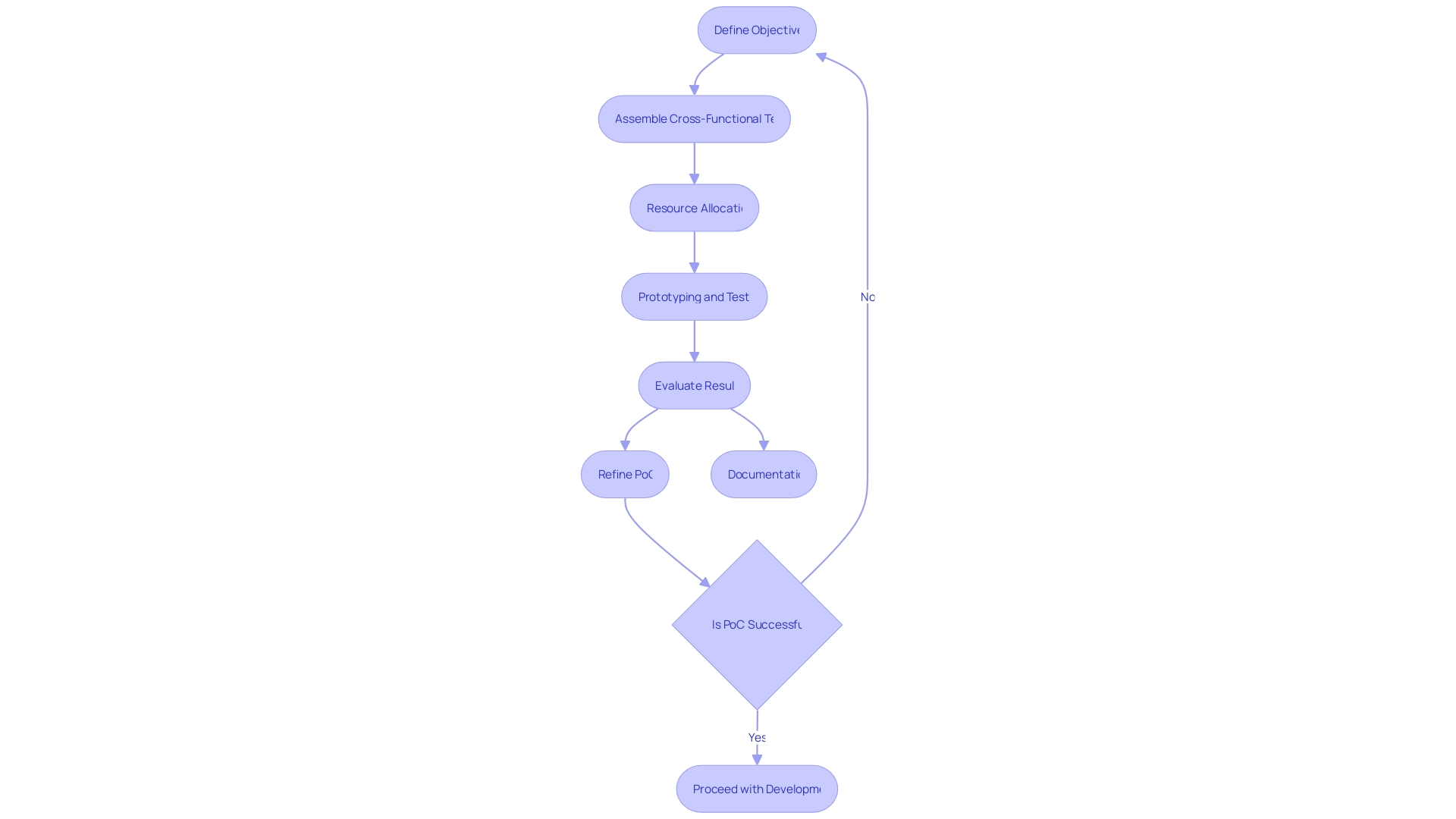
Understanding the Purpose of a Proof of Concept
In the dynamic realm of software development, a proof of concept (PoC) is a pivotal step that serves as a project's backbone, addressing the technical viability of a proposed solution. It is more than just a preparatory phase; it's a strategic exploration that uncovers potential risks and ensures that the software can withstand the demands of performance and scalability.
A PoC enables a tangible preview of the software's capabilities, offering stakeholders a snapshot of the possible end product and guiding crucial decision-making processes. A recent breakthrough in AI-driven software validation, developed by computer scientists and referred to as Baldur, has showcased the power of automation in generating proofs to verify software correctness.
This innovative approach has demonstrated an efficacy of nearly 66%, marking a significant advancement in the field. It's a clear indicator of the importance of verification and validation in software development, ensuring that the final product not only functions correctly but also fulfills the intended user needs and business goals.
In this context, prototypes play a vital role. They are akin to the architectural scale models used by builders to visualize and refine their designs.
In software development, prototypes can range from basic wireframes to interactive simulations, providing a framework to understand the problem at hand and test solutions in real-world scenarios. The use of prototypes is not merely for visual representation; they are fundamental tools that question, "What happens when we try this?" leading to valuable insights that drive innovation. Alpha and beta testing further extend the validation process, involving end-users and stakeholders in a real-world environment to gather feedback and refine the software. This collaborative approach is essential for aligning the software with stakeholder expectations and achieving a high-quality, successful product. As the industry evolves, the integration of modern methods in software testing is increasingly recognized for its potential to deliver substantial cost savings and ROI, shifting the perception of QA from a cost center to a valuable investment.
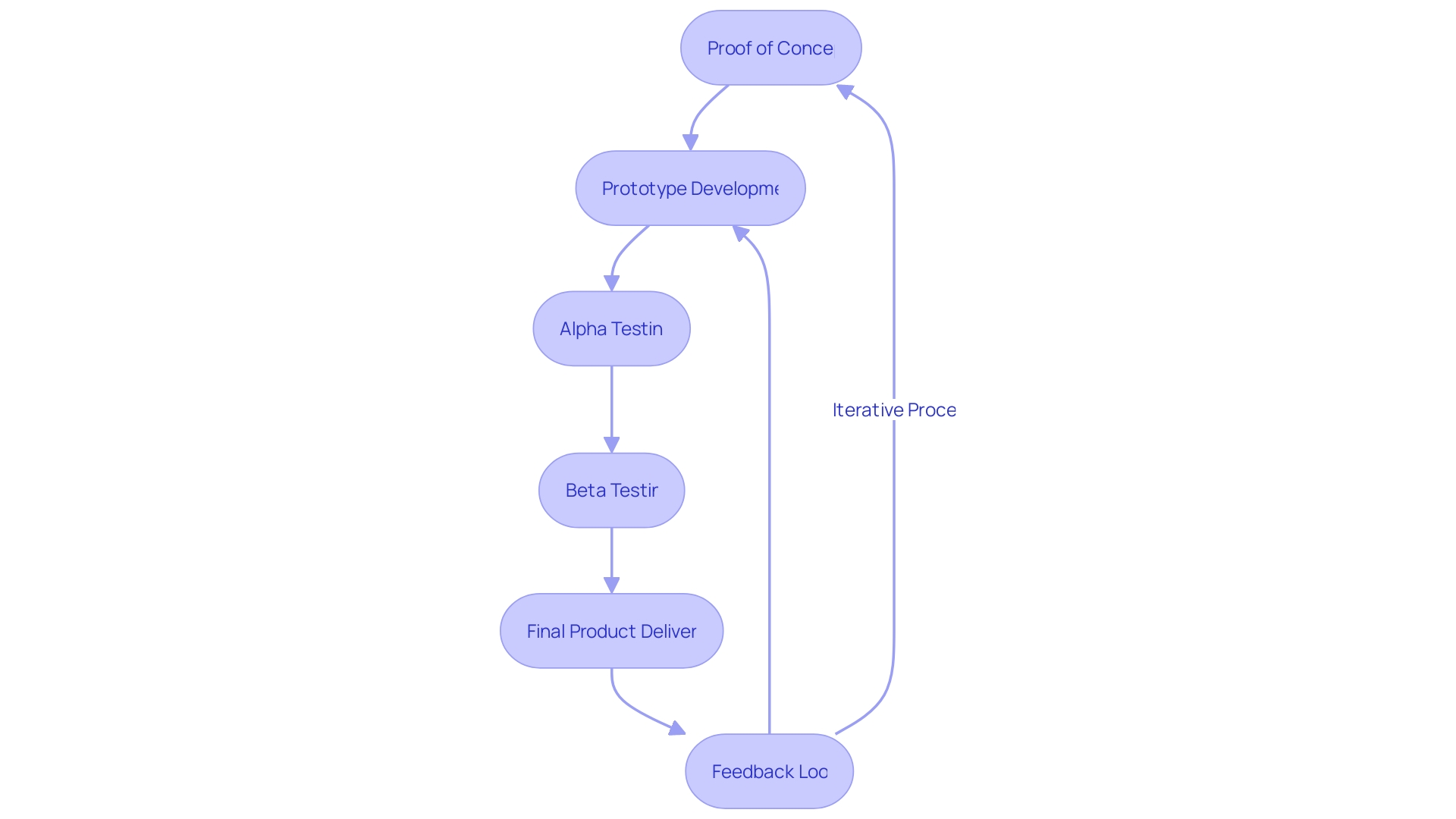
Key Steps in Creating a Proof of Concept for Software Development
To bring an innovative software concept to life, a Proof of Concept (PoC) is a critical step. It begins with a clear definition of the project's scope, objectives, and the essential features that the PoC must demonstrate. This precision in planning is vital to navigate the path ahead.
Once the project idea is crystallized, the next phase is resource identification and timeline establishment. This includes pinpointing the necessary technology platforms, tools, and expertise, and crafting a timeline that delineates the development and testing stages, ensuring a swift yet thorough approach to the PoC. Developing and testing the prototype is where strategic focus narrows to the core features.
It's about building a small-scale yet functional version of the software and rigorously testing it to assess performance, functionality, and user experience. This step is crucial as it sets the stage for the iterative process that follows. Upon reviewing and refining the PoC, feedback from stakeholders becomes the compass guiding enhancements.
Analyzing testing results and stakeholder input is instrumental in pinpointing areas for improvement, thereby perfecting the prototype. The presentation of the PoC to stakeholders is a pivotal moment, where a comprehensive display of key findings and benefits articulates the PoC's potential value and impact. This presentation is the bridge connecting the PoC with its future direction.
Finally, obtaining stakeholder feedback and making informed decisions shapes the trajectory of the project. Whether it's advancing to full-scale development or fine-tuning the PoC, this feedback loop is indispensable for steering the project towards success. Throughout this process, a balance between speed and thoroughness is key.
As Jason Fried, co-founder of 37Signals, suggests, launching a real product quickly to test the market can often be more valuable than extensive pre-launch validation. Additionally, the recent strategic alliance between Fabric Cryptography and =nil; Foundation, as reported by CNBC, underscores the importance of cutting-edge technology in streamlining the PoC process. In an ever-evolving tech landscape, the PoC is not just a checkpoint but a launchpad for innovation, driving forward with agility and foresight.
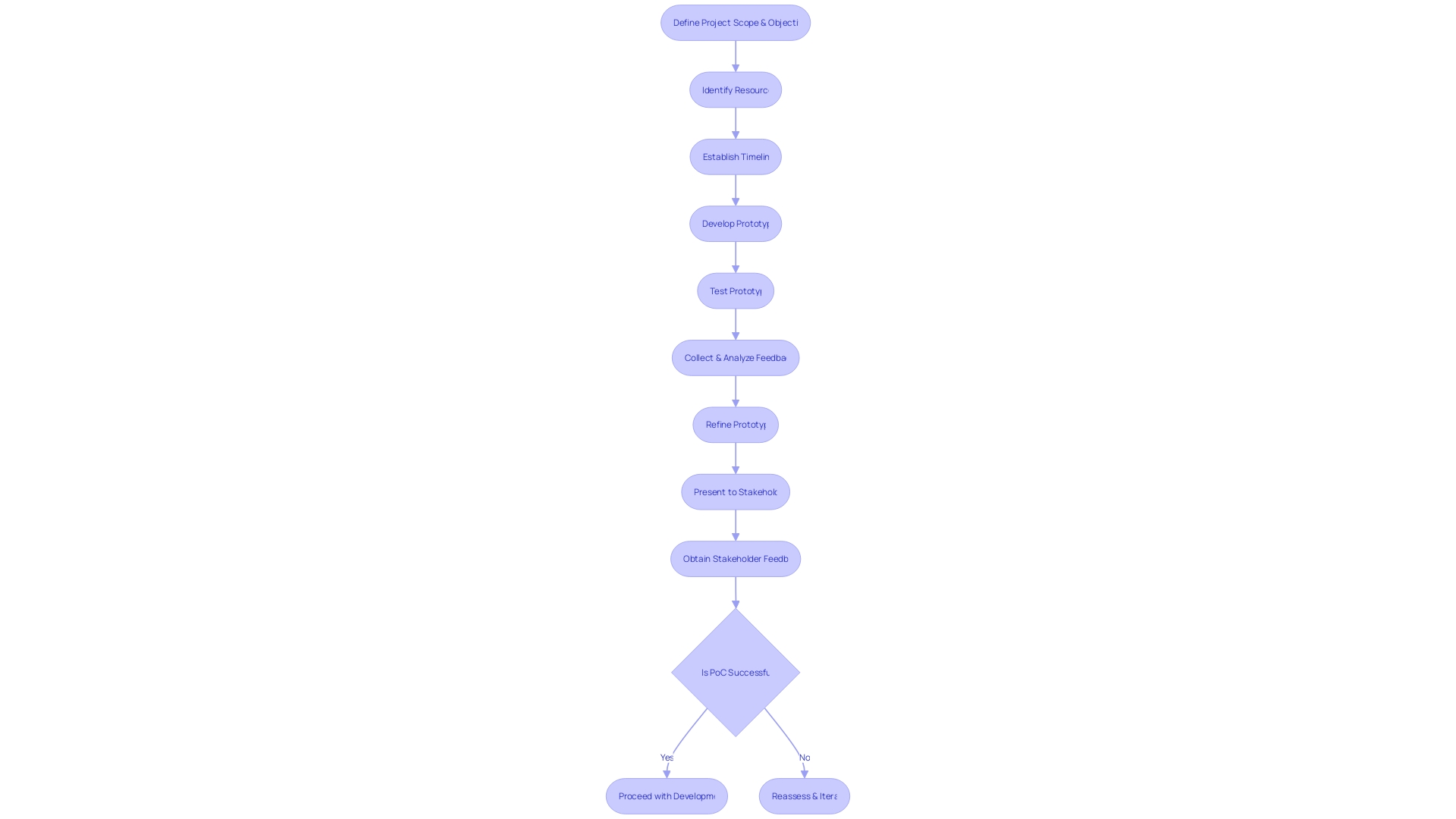
Real-World Examples of Proof of Concept in Software Development
Proof of concept (PoC) development serves as a vital step in the innovation journey across various industries, allowing companies to test the waters before diving into full-scale production. In the realm of autonomous vehicles, Pics are essential for testing complex technologies like computer vision and machine learning algorithms.
For instance, Forterra's work in the defense sector showcases the importance of autonomous technology in ensuring the safety of supply chains by removing drivers from high-risk situations. With the challenges of off-road driving in combat environments, PoCs are instrumental in assessing vehicle performance under extreme conditions.
Artificial Intelligence (AI) applications also benefit from PoCs, particularly in domains like natural language processing and predictive analytics. These early-stage projects help businesses gauge the capabilities of AI systems, providing insights into their future impact on employment and organizational structure.
The Internet of Things (IoT) solutions are another area where PoCs prove their worth by validating the feasibility of connected ecosystems for data collection and device integration. Similarly, blockchain technology, with its promises of enhanced security and scalability, relies on PoCs to test its applicability to specific business cases.
Recent news underscores the significance of PoCs, especially in the autonomous vehicle industry, where safety incidents can have far-reaching consequences. The setbacks faced by companies like Cruise highlight the importance of thorough testing and validation, as seen with the revocation of their operating permit following a series of safety incidents. In conclusion, PoCs are not just about proving a concept; they are about learning and adapting. As Jared Spool aptly noted, they are like an architect's scale model, offering a glimpse into the potential end result while allowing for adjustments before the final build. They are a cost-effective, risk-mitigating approach that can make all the difference in the successful implementation of cutting-edge technologies.
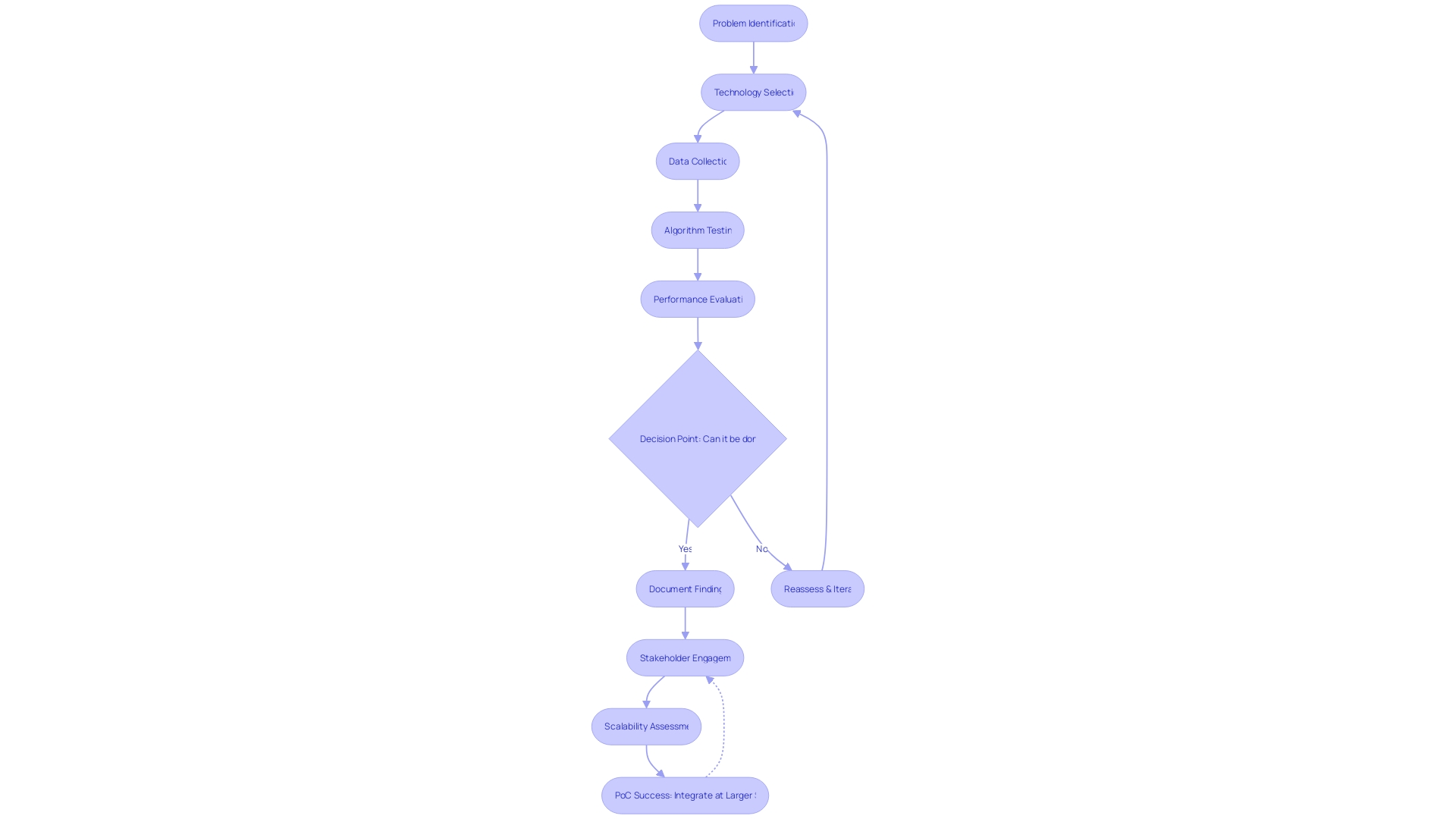
Common Misconceptions: Proof of Concept vs. Prototype vs. Minimum Viable Product
Navigating the landscape of software development involves distinguishing between key stages: Proof of Concept (PoC), Prototype, and Minimum Viable Product (MVP). Each serves a unique purpose in the journey from idea to market-ready product. A PoC is the initial step, a small experiment to test if a concept or idea is technically and commercially feasible.
It's akin to an architect's preliminary sketch, offering a glimpse of potential without the detail of the finished structure. Moving beyond the PoC, a Prototype presents a more tangible version of the idea, akin to the architect's detailed model. It showcases the proposed features, functionalities, and user interface, providing stakeholders a realistic preview and enabling user interaction testing.
The prototype's code may be temporary, but the insights gained are permanent, steering the project's direction. The MVP, however, is where concept meets execution. It's a basic yet functional iteration of the software, equipped with only the essential features to appeal to early adopters.
The MVP is pivotal for gathering user feedback and validating market demand within a short span, typically between 12 to 16 weeks, as opposed to the potentially years-long full development cycle. It's a strategic approach that balances risk, cost, and speed to market, particularly when resources are limited or when leveraging existing tools for a piecemeal MVP. By presenting users with a hands-on experience, the MVP facilitates an iterative feedback loop, essential for refining the product to meet market needs effectively.
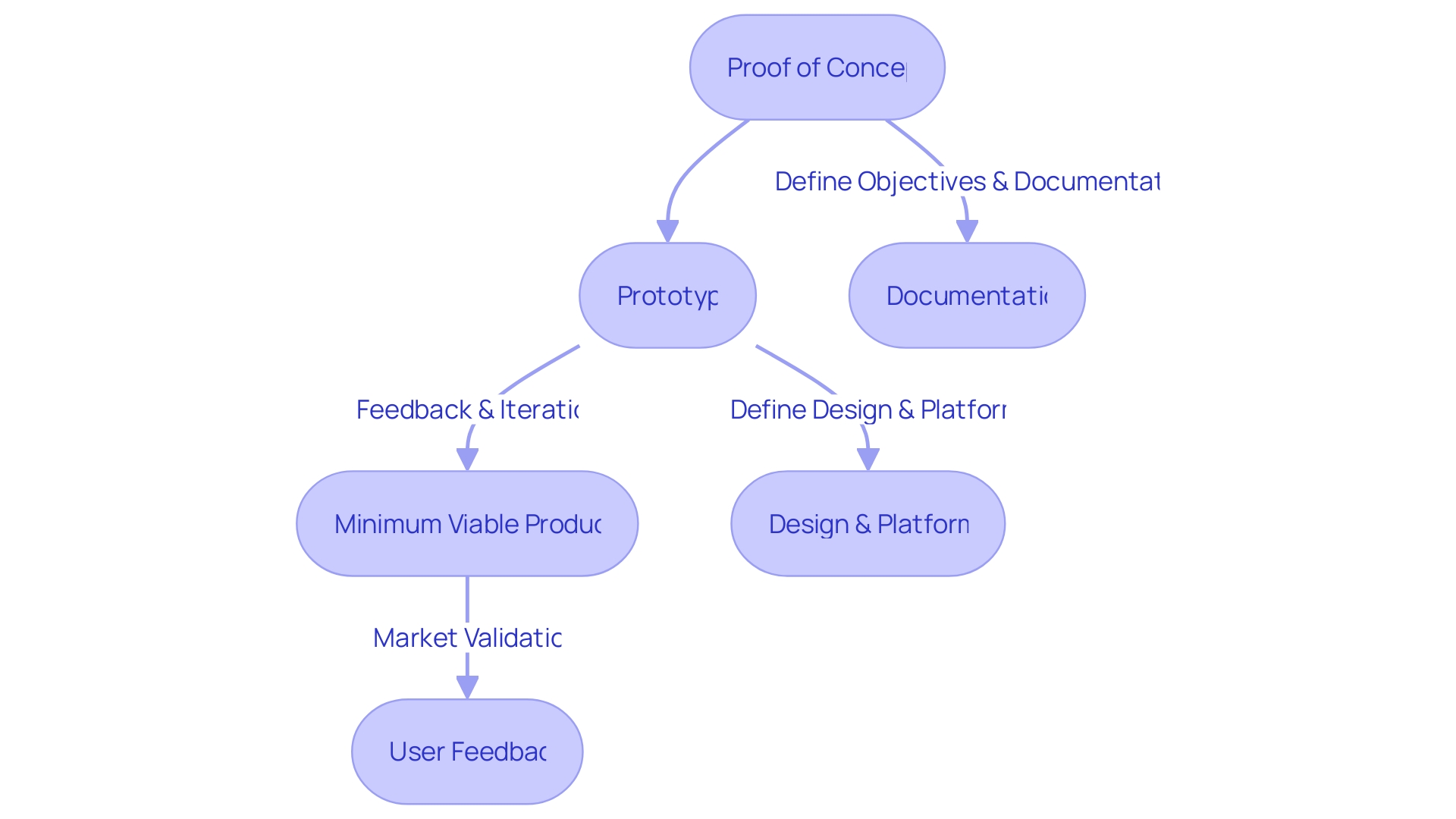
Best Practices for a Successful Proof of Concept in Software Development
Embarking on the custom software development journey requires a meticulous approach to ensure the project's success. Begin by clearly defining your business needs and establishing concrete goals and success criteria.
This will provide a solid foundation for your proof of concept (PoC) and ensure that every step taken aligns with your objectives. Focus on the core features and functionalities that will deliver the most value to your users.
This emphasis on user experience is crucial, as it shapes the overall satisfaction and engagement with your software. Remember, an MVP is like baking a basic cake—while it may not have all the decorations, it's still functional and provides a taste of the final product.
Keep the scope of your PoC manageable by leveraging existing tools and technologies. This not only saves valuable time and resources but also accelerates the time to market.
The insights from industry leaders highlight the importance of integrating security and quality assurance from the outset. By doing so, you create a more resilient and robust software solution that stands the test of time.
Involvement of stakeholders throughout the development process is indispensable. Their feedback is a treasure trove of insights, helping you to refine and iterate on your PC.
Document every step diligently, from the initial concept to the final stages of development. This not only provides a clear roadmap for your team but also ensures that you have a detailed record for future reference and improvement. As you evaluate and iterate on your PoC, consider the broader impact of your software solution. Communicate its potential value effectively to all relevant parties. With the rise of automated quality control and the need for a thorough chain of custody for code, it's more important than ever to understand the progression of your software through various systems. This level of transparency and control is key to addressing any issues swiftly and efficiently. In a nutshell, by adhering to these best practices, you're not just creating software; you're crafting a solution that propels your business forward in the digital era.
Conclusion
In conclusion, the Proof of Concept (PoC) phase in software development is a pivotal step that assesses the technical feasibility and market potential of an idea. By setting clear objectives, assembling diverse teams, and developing prototypes, software companies can lay a solid foundation for their projects.
Real-world examples across industries like autonomous vehicles, AI applications, IoT solutions, and blockchain technology highlight the importance of PoCs in driving innovation and validating ideas. Understanding the distinctions between PoCs, prototypes, and MVPs is crucial.
PoCs test feasibility, prototypes offer tangible versions for user interaction testing, and MVPs validate market demand quickly. Best practices for successful PoCs include defining clear goals, prioritizing user experience, leveraging existing tools, involving stakeholders throughout the process, documenting diligently, and communicating value effectively. By embracing agility and foresight in the dynamic tech landscape, software companies can navigate challenges confidently and drive innovation efficiently. The PoC phase propels businesses forward in the digital era.





